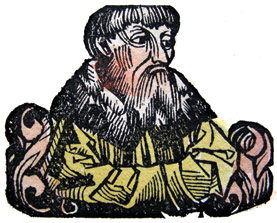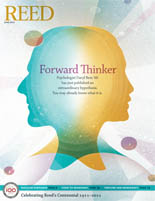
IRIS login | Reed College home Volume 90, No. 2: June 2011
Classic Lectures
Ionian Thinkers (continued)

Heraclitus
Notice that the transformations are cyclical. When they are complete, what started as fire ends up being fire again.
否
To see how Heraclitus answered the question about what happens to fire when strife causes it to become air, we must begin, as he surely did, with Anaximenes. In Anaximenes’ view, elements change into one another by becoming more rarified or more condensed. But this account is uneconomical because it introduces a new primitive notion—rarifaction/condensation—over and above the original four elements. Heraclitus seems to have noticed this defect in Anaximenes’ theory and tried to rectify it. In his view, all that happens when fire is transformed into air is that it dies down. Thus Road A (the downward road) is the progressive dying down of fire and Road B (the upward one) is its progressive rekindling. Thus only fire “being kindled in measures and being extinguished in measures,” is needed to explain how strife (justice) causes the elements to be transformed into one another, so that their cyclical transformations are simply “the turnings of fire.”
部
One final theoretical advantage of fire deserves to be mentioned. Fire exists through striving with its fuel, but its striving is law-governed or measured:
Earth is poured out as sea, and is measured according to the same ratio (logos) it was before it became earth.
After all, the size or heat of fire is proportional to the amount of fuel being consumed. Thus if fire is the fundamentally real thing, this offers an explanation of the order observed in such things as the seasons and the rising and setting of the sun.
There is no doubt that the theory that results from these reductions is vastly more successful than any of the theories of Heraclitus’ predecessors. It is also fundamentally different in kind. Heraclitus doesn’t tell us that the cosmos and all its contents are fundamentally fire, he tells us that they are fire “being kindled in measures and being extinguished in measures.” This emphasizes the fact that what is fundamentally real for Heraclitus is not a static stuff to which change and activity are extrinsic, but a law-governed process or activity. Heraclitus differs from his predecessors, then, not simply in choosing fire rather than water, air, or the unlimited as his primary stuff, but in choosing law-governed change over static stability as being more fundamentally real. In the worlds of Thales, Anaximander, and Anaximenes, change depends on stability; in Heraclitus’ world, stability depends on change: “Changing, it rests.”
Heraclitus’ powerful vision of the world exerted enormous influence over his successors, who tried in various ways to destroy, criticize, modify, and augment it. But it is not his theory so much as the spirit in which he offers it, that I have wanted to emphasize. He wasn’t the first to theorize in that spirit, he was part of a tradition of critical rationality that already existed. But he was the first to give explicit voice to it:
Listening not to me but to the logos it is wise to agree that all things are one.
This is the injunction that all the subsequent Greek philosophers follow. As students of Greek philosophy, it is an injunction we must strive to follow ourselves. If we do, we will become what so many Greek philosophers thought was the best thing to be: critically rational human beings.
These classic Hum lectures were selected by Peter Steinberger [political science and humanities 1977–].
Further Reading
Patricia Curd, ed., A Presocratics Reader (Indianapolis: Hackett, 1996)
Charles Kahn, The Art and Thought of Heraclitus (Cambridge: Cambridge University Press, 1979)
Karl Popper, “Back to the Presocratics,” in his Conjectures and Refutations (London: Routledge, 1963)
- Previous Page
- 1
- 2
- 3
- Next Page


LATEST COMMENTS
steve-jobs-1976 I knew Steve Jobs when he was on the second floor of Quincy. (Fall...
Utnapishtim - 2 weeks ago
Prof. Mason Drukman [political science 1964–70] This is gold, pure gold. God bless, Prof. Drukman.
puredog - 1 month ago
virginia-davis-1965 Such a good friend & compatriot in the day of Satyricon...
czarchasm - 4 months ago
John Peara Baba 1990 John died of a broken heart from losing his mom and then his...
kodachrome - 7 months ago
Carol Sawyer 1962 Who wrote this obit? I'm writing something about Carol Sawyer...
MsLaurie Pepper - 8 months ago
William W. Wissman MAT 1969 ...and THREE sisters. Sabra, the oldest, Mary, the middle, and...
riclf - 10 months ago